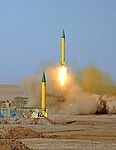Shahab-1
| Shahab-1 | |
|---|---|
 | |
| Type | Tactical SRBM |
| Service history | |
| In service | ~1987–2016 (in Iran)[1] |
| Production history | |
| Manufacturer | Iran |
| Specifications | |
| Mass | 5,860 kg |
| Length | 10.94 m |
| Diameter | 0.885 m |
| Warhead | 1,000 kg |
Operational range | 350 km[2] |
Guidance system | Inertial |
| Accuracy | approximately 450m circular error probable (CEP) |
The Shahab-1 (Persian: شهاب ۱, romanized: Ŝahāb 1, meaning "Meteor-1") was the foundation of the short-range Iranian missile program.[3] During the Iran–Iraq War, Iran purchased R-17 Elbrus missiles from Libya, Syria and North Korea (Hwasong-5). It is a close copy of Hwasong-5 (R-17).[4]
Iran began making the Shahab-1 sometime between 1985 and 1988.[3] Iran's Shahab-1 is a short-range ballistic missile derived from the Scud-B, and has a maximum range of 300 km (185 miles).[5]
Iran employed Shahab 1s extensively during the 1990s and early 2000s against Mujahidin-e Khalq Organization (MKO) camps in Iraq.[4]

Variants
[edit]Shahab is the name of a class of Iranian missiles, service time of c. 1987–present,[when?] which comes in six variants: Shahab-1, Shahab-2, Shahab-3, Shahab-4, Shahab-5, and Shahab-6.[citation needed]
Operators
[edit]Gallery
[edit]- Shahab-1 launch day, 3 July 2012
-
Operational pre-launch
-
Lift-off (cropped)
-
Lift-off
-
Flight (cropped)
-
Flight
See also
[edit]- Military of Iran
- Islamic Revolutionary Guard Corps Aerospace Force
- Defense industry of Iran
- List of equipment of the Iranian Army
- Shahab-2
- Shahab-3
- Shahab-4
References
[edit]- ^ تولید موشک شهاب ۱ و ۲ متوقف شد/ هیچیک از موفقیتهای ایران با سازش به دست نیامدهاست Mashregh News
- ^ "2017 ballistic and cruise missile threat". Archived from the original on 18 July 2017.
- ^ a b "SCUD-B Shahab-1". Retrieved 30 April 2011.
- ^ a b "Shahab-1 (Scud B-Variant)".
- ^ "Shahab 1 – Missile Defense Advocacy Alliance". Retrieved 29 August 2022.
- ^ "Syria's Scientific Studies and Research Center". storymaps.com. 20 October 2020. Retrieved 23 July 2023.
External links
[edit]







